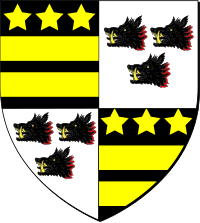| Baron Carbery | |
|---|---|
 Quarterly 1st & 4th: Freke; 2nd & 3rd: Evans [1] | |
| Creation date | 1715 |
| Peerage | Peerage of Ireland |
| Remainder to | the 1st Baron father's heirs male of the body lawfully begotten |
| Subsidiary titles | Baronet Freke (1768) |
Baron Carbery, of Carbery in the County of Cork, is a title in the Peerage of Ireland. It was created in 1715 for George Evans, with remainder to the heirs male of his father and namesake George Evans, a supporter of William and Mary during the Glorious Revolution, who had earlier declined the offer of a peerage. After his elevation to the peerage, Lord Carbery represented Westbury in the House of Commons. He was succeeded by his eldest son, the second Baron. He also sat as Member of Parliament for Westbury. His grandson, the fourth Baron, briefly represented Rutland in Parliament. He was succeeded by his uncle, the fifth Baron. On his death, the line of the eldest son of the first Baron failed. He was succeeded by his first cousin once removed, the sixth Baron, who had previously succeeded his father as second Baronet, of Castle Freke. Lord Carbery sat in the House of Lords as an Irish representative peer from 1824 to 1845. His nephew, the eighth Baron, was an Irish Representative Peer from 1891 to 1894. As of 2014 [update] the titles are held by the latter's great-great-grandson, the twelfth Baron, who succeeded his father in 2012.
Contents
- Barons Carbery (1541)
- Barons Carbery (1715)
- Freke, later Evans-Freke baronets, of Castle Freke (1768)
- References
- Sources
The Baronetcy, of Castle Freke in the County of Cork, was created in the Baronetage of Ireland in 1768 for John Evans-Freke, son of Grace daughter and heiress of Sir Ralph Freke, 1st Baronet of West Bilney Norfolk [2] and the Hon. John Evans, younger son of the first Baron Carbery. On his death, the title passed to his son, the second Baronet. In 1807 he succeeded his first cousin once removed as sixth Baron Carbery. The titles have remained united since.
As of 28 February 2014, the present Baronet has not successfully proven his succession and is therefore not on the Official Roll of the Baronetage, with the baronetcy considered dormant since 2012. [3]

